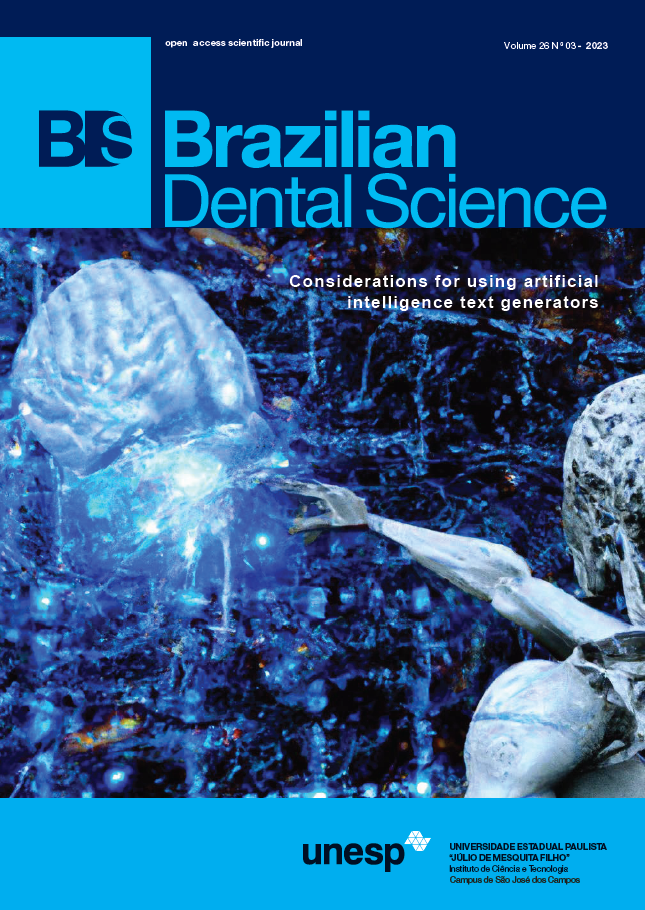The Effect of Immediate Dentin Sealing on the Marginal Adaptation of Lithium Disilicate Overlay Restorations using different types of luting agents
DOI:
https://doi.org/10.4322/bds.2023.e3925Resumo
Objective: This study evaluated the effect of immediate dentin sealing on the marginal adaptation of lithium disilicate overlays with three different types of resin-luting agents: preheated composite, dual-cure adhesive resin, and flowable composite. Materials and Methods: Forty-eight maxillary first premolars of similar size were prepared with a butt joint preparation design. The teeth were separated into two primary groups, each with twenty-four teeth: Group DDS: Delay dentin sealing (non-IDS) teeth were not treated. Group IDS: dentin sealing was applied immediately after teeth preparation. Each group was subsequently separated into three separate subgroups. Subgroups (DDS+Phc, IDS+Phc): cemented with preheated composite (Enamel plus HRi, Micerium, Italy), Subgroups (DDS+Dcrs, IDS+Dcrs): cemented with dual-cured resin cement (RelyX Ultimate, 3M ESPE, Germany) and Subgroups (DDS+Fc, IDS+Fc): Cemented with flowable composite (Filtek supreme flowable, 3M ESPE, USA). Using a digital microscope with a magnification of 230x, the marginal gap was measured before and after cementation at four different locations from each surface of the tooth, and the mean of measurements was calculated and analyzed statistically using the independent t-test, one-way ANOVA test, Bonferroni correction at a significance level of 0.05. Results: The samples that were immediately sealed with dentin bonding agent showed lower marginal gaps than delayed dentin sealing, both pre-and post-cementation for all subgroups, with a statistically significant difference (p < 0.01). The marginal gap was significantly lower in the IDS+Fc (48.888 ± 5.5 micro m) followed by the IDS+Dcrs group (53.612 ±5.8 micro m) and IDS+Phc (79.19 9±6.9 micro m) respectively, while the largest marginal gaps were observed in the DDS+Phc group (86.505 ± 5.4 micro m). Conclusion: Generally, the teeth with IDS showed better marginal adaptation than teeth without IDS. The marginal gap was smaller with flowable composite and dual-cure resin cement than with preheated composite.
KEYWORDS
CAD-CAM; Cementation; Dental marginal adaptation; Dental Porcelain; Resin cement.
Downloads
Downloads
Publicado
Como Citar
Edição
Seção
Licença
TRANSFERÊNCIA DE DIREITOS AUTORAIS E DECLARAÇÃO DE RESPONSABILIDADE
Toda a propriedade de direitos autorais do artigo "____________________________________________________________________" é transferido do autor(es) para a CIÊNCIA ODONTOLÓGICA BRASILEIRA, no caso do trabalho ser publicado. O artigo não foi publicado em outro lugar e não foi submetido simultaneamente para publicação em outra revista.
Vimos por meio deste, atestar que trabalho é original e não apresenta dados manipulados, fraude ou plágio. Fizemos contribuição científica significativa para o estudo e estamos cientes dos dados apresentados e de acordo com a versão final do artigo. Assumimos total responsabilidade pelos aspectos éticos do estudo.
Este texto deve ser impresso e assinado por todos os autores. A versão digitalizada deverá ser apresentada como arquivo suplementar durante o processo de submissão.




























